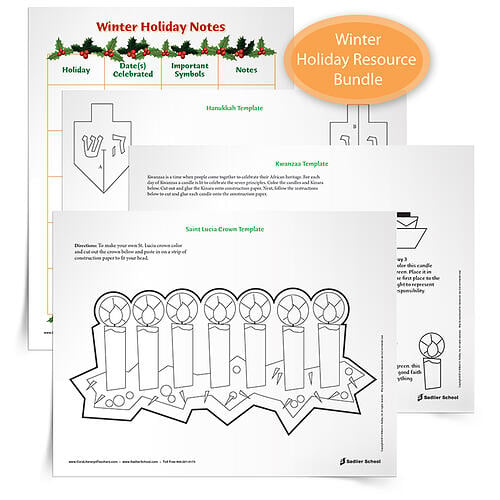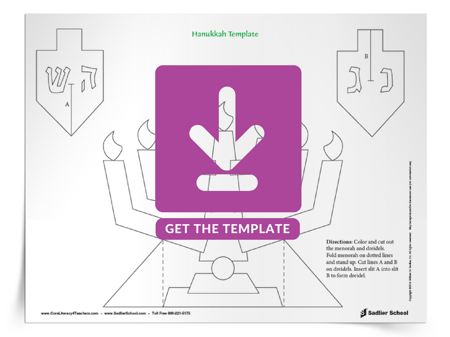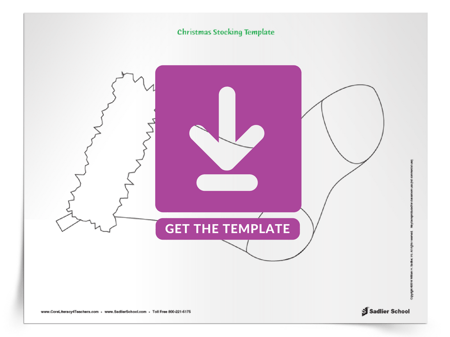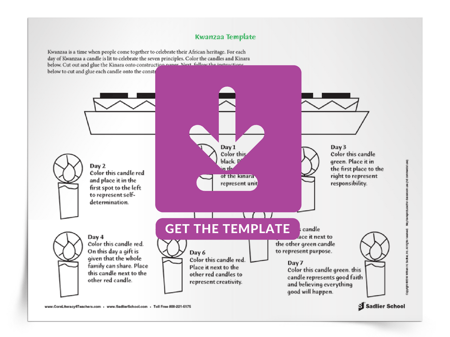December 8, 2022 CL Seasonal Activities Winter, CL Lesson Plans, ELA Seasonal - Winter, ELA K-5, ELA Focus - Reading, ELA Resources - Activities, Core Literacy
Winter Holidays Around the World– Lesson Plans for Elementary Students
By: Erin Lynch
The holiday season is a great time to incorporate cultural awareness into instruction! With the "Winter Holidays Around the World" lesson plans, students will learn about various holiday celebrations around the world. The five celebrations featured in the "Winter Holidays Around the World" lesson plans are Hanukkah, Christmas, Saint Lucia Day, Kwanzaa, and Saint Nicholas Day.
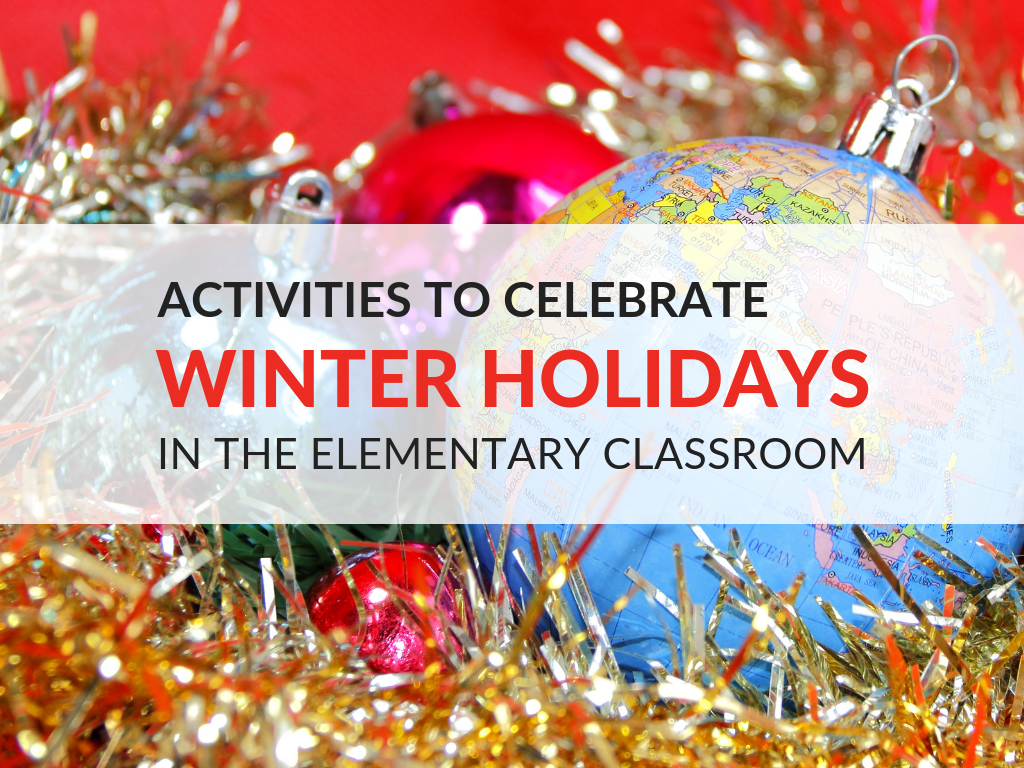
Winter Holidays Around the World Lesson Plan
Educators have a responsibility to acknowledge the differences among students and foster cultural awareness in the classroom. Teach students about different winter holidays with the "Winter Holidays Around the World" lesson. Use the Winter Holiday Resource Bundle to assist students in taking notes about important aspects of each holiday and to make crafts that symbolize each holiday.
Getting Started
The "Winter Holidays Around the World" lesson plans are typically completed in collaboration with other classrooms and are set up as a rotation. For example, there were five third-grade teachers on our team in Maryland. Each of my teacher teammates and I selected a different winter holiday to teach our students about and created a corresponding craft. The students would rotate through each classroom to learn about holiday celebrations around the world and make a craft symbolizing each holiday.
If you don't have a team of teachers you can work with, you can easily modify this idea for your classroom. Choose a different holiday to explore with your students each day of the week sometime before winter vacation.
How it works
-
Give students a brief overview of the holiday.
-
Have students take notes about important aspects of the holiday. A Holiday Notes Organizer is available for you to download.
-
Share a book about the holiday.
-
Have students complete a craft that symbolizes the holiday.
-
Optional - The CCSS requires students to compare and contrast different texts on a similar topic. Using a Venn diagram, have students select two holidays of their choice to compare and contrast.
Hanukkah Activities for Elementary Students
Brief Overview
Hanukkah is the Jewish Festival of Lights. It commemorates the rededication of the Second Temple in Jerusalem. This happened around 160 BCE (Before Common Era). (Hanukkah is the Jewish word for “dedication.”) Hanukkah lasts for eight days and starts on the 25th of Kislev, the month in the Jewish calendar that occurs at about the same time as December. Because the Jewish calendar is lunar — that is, it is based on the cycles of the moon, Kislev occurs between late November and late December.
The Temple was damaged during the Maccabean Rebellion and when the fighting ended, it was discovered that there was only enough consecrated oil to burn in the temple lamp for one day. However, a miracle occurred and the oil lasted for eight days. It is for this reason that Hanukkah is celebrated over eight days.
On each of the eight nights of Hanukkah, a candle is lit on a special menorah, or candelabra, called a “hanukkiyah.” There is a special ninth candle called the “shammash,” or servant candle, which is used to light the other candles. The shammash is generally in the center of the other candles and in a higher position. On the first night one candle is lit; on the second night, two are lit, and so on. This continues until all the candles are lit on the eighth and final night of Hanukkah. Traditionally they are lit from left to right. A special prayer is said before or after lighting the candles and a special Jewish hymn is often sung. The menorah is usually placed in the front window of houses so people can see the lights and remember the Hanukkah miracle. Most Jewish families and households have a special menorah and celebrate Hanukkah.
Small gifts are often given on each night of Hanukkah and many games are played. The most popular game is called “dreidel” in Yiddish, or “sivivon” in Hebrew. A dreidel is a four-sided top with a Hebrew letter on each side. The four letters are the first letter of the phrase “Nes Gadol Hayah Sham,” which means, “A great miracle happened there” (in Israel, “there” is changed to “here,” so the expression is “Nes Gadol Hayah Po”).
Players put a coin, nut, or chocolate coin into a pot and the top is spun. If the letter “nun” (ג) comes up, nobody wins. If it's “gimel” (ג), the player wins the pot. If it's “hay” (ה) he wins half the pot. If it's “shin” (ש, for “there”) or “pe” (פ, for “here”) the player puts another item into the pot and the next person spins the top.
Foods fried in oil – representing the oil in the temple lamp – are traditionally eaten during Hanukkah. Favorites are “latkes,” which are potato pancakes, and “sufganiyot,” which are deep-fried doughnuts that are then filled with jam or jelly and sprinkled with sugar.
Book for Read Aloud
One of my favorite books to read aloud to students is Hanukkah! by Roni Schotter. This joyful story is the perfect way to celebrate the festival of lights!
Holiday Craft
To finish the Hanukkah mini-unit, have students create a Menorah & Dreidel. Download the Menorah and Dreidel template to use with your students.
St Lucia Day Activities for Elementary Students
Brief Overview
Most people in Scandinavian countries honor Saint Lucia (also known as Saint Lucy) each year on December 13. Saint Lucia Day festivities began in Sweden, but had spread to Denmark and Finland by the mid-19th century. In these countries, the holiday is considered the beginning of the Christmas season.
The oldest daughter in each family gets up early and dresses in a long, white gown with a red sash. She wears a crown made of twigs with nine lighted candles and wakes each of her family members. For the day, she is called “Lussi” or “Lussibruden (Lucy bride).” The family then eats breakfast, which includes special buns, in a room lighted with candles.
According to tradition, at night, men, women, and children would carry torches in a procession. Then, everyone threw the torches onto a large pile of straw, creating a huge bonfire. In Finland today, one girl serves as the national Lucia and she is honored in a parade in which she is surrounded by torchbearers.
Light is a main theme of Saint Lucia Day because her name, which comes from the Latin word lux, means “light.” Her feast day is celebrated near the shortest day of the year, when the days begin to grow longer.
Book for Read Aloud
The book I share with students is Lucia, Saint of Light by Katherine Bolger Hyde. Lucia, Saint of Light introduces young readers to Saint Lucia's life and her delightful Christmas-related festival as it is traditionally celebrated in Sweden and around the world. Daria Fisher's warm and vivid illustrations will make this book a favorite with children!
Holiday Craft
Now that students have learned about Saint Lucia, have them create their own Saint Lucia crown! Using construction paper for the base of the crown and the Saint Lucia template, students can assemble their own beautiful crown to take home!
St Nicholas Day Activities for Elementary Students
Brief Overview
Saint Nicholas was a Bishop who lived in the fourth century CE in a place called Myra, in Asia Minor (now Turkey). His parents died when he was young and left him a lot of money. He was also a very kind man who had a reputation for helping the poor and giving secret gifts to people in need. There are several legends about Saint Nicholas. The most famous story about Saint Nicholas tells how the custom of hanging up stockings on Christmas Eve first started.
There was a poor man who had three daughters. He was so poor that he did not have enough money for a dowry, so his daughters couldn't get married. (A dowry is a sum of money paid to the bridegroom by the bride’s parents on the wedding day. This still happens in some countries.) One night, Nicholas secretly dropped a bag of gold down the chimney, so that the oldest daughter could be married. The bag fell into a stocking that had been hung by the fire to dry. The same thing happened again with the second daughter.
Finally, determined to find out who had left the money, the father secretly hid by the fire every evening until he caught Nicholas dropping in a bag of gold. Nicholas begged the man to not tell anyone what he had done, because he did not want to bring attention to himself. But soon the news got out and when anyone received a secret gift, it was thought that maybe it was from Nicholas. Because of his kindness, Nicholas was made a saint.
Saint Nicholas is not only the patron saint of children but also of sailors. One story tells of him helping some sailors who were caught in a terrible storm off the coast of Turkey. The storm was raging around them and all the men were terrified that their ship would sink beneath the giant waves. They prayed to Saint Nicholas to help them. Suddenly, he appeared on the deck before them. He ordered the sea to be calm, the storm died away, and they were able to sail their ship safely to port.
Saint Nicholas was exiled from Myra and later put in prison by the Emperor Diocletian. No one knows exactly when he died, but it was on December 6 in either 345 or 352 CE. In 1087, his bones were taken from Turkey by Italian merchant sailors. The bones are now kept in the Church named after him in the Italian port city of Bari. On Saint Nicholas’s feast day (December 6), the sailors of Bari still carry his statue from the Cathedral out to sea, so that he can bless the waters and give them safe voyages all year.
Book for Read Aloud
For Saint Nicholas Day we read The Baker's Dozen: A Saint Nicholas Tale by Aaron Shepard. This book is about a baker well known for his honesty and his fine Saint Nicholas cookies. When a mysterious old woman curses the baker's business, he believe only Saint Nicholas can help!
Holiday Craft
Have students color and decorate their own Christmas stocking using my printable template.
Christmas Activities for Elementary Students
Brief Overview
Christmas is the celebration of the birth of Jesus Christ, who Christians believe is the Son of God.
Many people think Christmas happens only on December 25, and that's all there is to it. However, for many people around the world who follow different Christian traditions, Christmas lasts for a lot longer than that – and it's even celebrated at different times.
Although December 25 is the date when most people celebrate Christmas, it is celebrated on other dates as well. Some churches (mainly Orthodox churches) use a different calendar, such as the old “Julian” calendar for their religious celebrations, and people in those churches celebrate Christmas on January 7.
Most people in the Greek Orthodox Church celebrate Christmas on December 25, but some still use the Julian calendar and so celebrate Christmas on January 7. Some Greek Catholics also celebrate on January 7. In Armenia, the Apostolic Church celebrates Christmas on January 6. It also celebrates Epiphany on this day, which is the day that the Three Wise Men arrived in Bethlehem.
Many Christians use Advent to prepare themselves to celebrate the joy of Christmas. Advent normally lasts for four Sundays and weeks before Christmas. However, in many Orthodox and Eastern Catholic Churches, Advent lasts for 40 days and starts on November 15. In Orthodox Churches that celebrate Christmas on January 7, Advent starts on November 28. During Advent, many people fast, or don't eat certain foods. The type of food people give up depends on their church tradition and where in the world they live.
Book for Read Aloud
For the Christmas unit share The Story Of Christmas by Vivian French. This book offers a simple retelling that follows Mary and Joseph as they journey to Bethlehem and then celebrate the birth of Jesus with the shepherds and wise men. Complemented by Jane Chapman’s vivid and joyful illustrations, here is a Christmas story that is sure to appeal to the youngest of children.
Holiday Craft
Have students make a hand print Advent wreath. Either cut out green construction paper hands (each student traces their own hand to use as a template) or, using green paint, the students can make hand prints on white paper for the greenery. Use pink and purple construction paper for the candlesticks and yellow construction paper for the flames.
Kwanzaa Activities for Elementary Students
Brief Overview
The name Kwanzaa comes from the phrase “matunda ya kwanza,” which means “first fruits” in Swahili. Each family celebrates Kwanzaa in their own way, but celebrations often include songs and dances, African drums, storytelling, poetry reading, and a large traditional meal. Kwanzaa is celebrated over seven nights.
On each night, the family gathers and a child lights one of the candles on the Kinara (candleholder). Then, one of the seven principles, or Nguzo Saba in Swahili, is discussed. The principles were created by Dr. Maulana Karenga, and are values of African culture that build and reinforce community among African-Americans.
Kwanzaa also has seven symbols, which represent values and concepts that reflect African culture. The candle-lighting ceremony each evening allows the family to gather and discuss the meaning of Kwanzaa. The first night, the black candle in the center of the Kinara is lit (and the principle of umoja, or unity, is discussed). One additional candle is lit each evening and the corresponding principle is discussed. Each day of Kwanzaa emphasizes a different principle. Here are the seven principles:
Unity: Umoja (oo–MO–jah)
To strive for and maintain unity in the family, community, nation, and race.
Self-determination: Kujichagulia (koo–gee–cha–goo–LEE–yah)
To define ourselves, name ourselves, create for ourselves, and speak for ourselves.
Collective Work and Responsibility: Ujima (oo–GEE–mah)
To build and maintain our community together and make our brothers’ and sisters’ problems our problems and to solve them together.
Cooperative Economics: Ujamaa (oo–JAH–mah)
To build and maintain our own stores, shops, and other businesses, and to profit from them together.
Purpose: Nia (nee–YAH)
To make our collective vocation the building and developing of our community in order to restore our people to their traditional greatness.
Creativity: Kuumba (koo–OOM–bah)
To do always as much as we can, in the way we can, in order to leave our community more beautiful and beneficial than we inherited it.
Faith: Imani (ee–MAH–nee)
To believe with all our heart in our people, our parents, our teachers, our leaders, and the righteousness and victory of our struggle.
Book for Read Aloud
A great book to use for a read aloud is Seven Candles for Kwanzaa by Andrea Davis Pinkney. For more than 25 years, African-American families have celebrated Kwanzaa – a holiday, inspired by their ancestors, that celebrates the harvest season. With a rich, informative text and stunning four-color illustrations, this book will help young children to begin their own Kwanzaa celebration.
Holiday Craft
Have students color and assemble a Kinara using my printable template.



